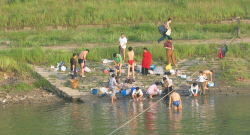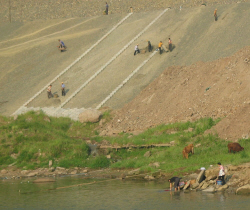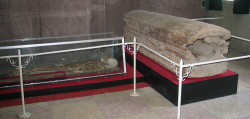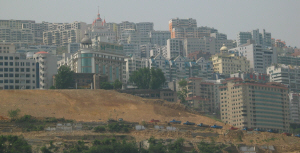|
Sunday, April 30 Wanxian
Wanxian, a trading center and
port for ships, is the largest city to be flooded by the rising waters of the
Three Gorges reservoir. About 8:30 that morning we again disembarked from the
ship, this time to visit firsthand the home of a local family who had been
forced to relocate when their village was submerged. We had to walk up a steep
staircase leading from the dock up to the city because a tram wasnít
operating. We visited a husband and wife who now lived in an 8-story condominium. They were lucky because they had gotten a first-floor apartment. There are no elevators in apartment buildings of 8 floors or less, so occupants of the top stories have quite a climb. This couple had formerly been farmers along the river who grew wheat and vegetables, mostly for their own consumption, and raised a couple of pigs and some chickens and ducks. Apparently, the animals provided some income for other necessities.
As we continued cruising, we saw steep mountains with terraces going all the way to the top. No hillsides seemed too steep to grow their crops. In some plots, the crop rows ran up and down the slopes, which surprised me, because I would have thought erosion would have been a problem. All the plots looked very small and are farmed by hand. It apparently was harvest time for the canola (rapeseed) because the mature plants had been cut, tied in small bundles, and left lying in the plots to dry.
One of the more phenomenal
aspects of the Three Gorges Project is the relocation of major cities and towns
plus the entire infrastructure that goes with resettling 1.3 million people. It
isnít hard to see why we have a shortage of cement in this country when you
see the tremendous amount of construction in China. One member of our group,
Chuck Schlick, who with his wife, Deanna, made this same trip in 1999, was
astounded by how many banks and banks of new high rise condominiums have sprung up
above the old cities. We arrived at Fengdu at 7:30 pm and were told that the river was too shallow to go any further. We would transfer to a bus in the morning for the final leg of our trip to Chungqing. Fengdu, on the northern bank of the Yangtze will be completely submerged when the Three Gorges reservoir fills up. |
 Our ship had docked at Wanxian
overnight and when I got up the next morning to do my one-mile walk around the
deck (7 laps). I was fascinated by the crowd of people bathing and washing
laundry in the river. Men, stripped to their skivvies, were bathing and women
were hand washing garments in what seemed to be pretty dirty water.
Our ship had docked at Wanxian
overnight and when I got up the next morning to do my one-mile walk around the
deck (7 laps). I was fascinated by the crowd of people bathing and washing
laundry in the river. Men, stripped to their skivvies, were bathing and women
were hand washing garments in what seemed to be pretty dirty water. Nearby a handful of men were
working on this Sunday morning hand carrying soil and cement blocks down a steep
slope to rip rap the
river bank in anticipation of another 60 foot rise in the river level by October
of this year. The current level is at about 138 meters and will go up to 156 m.
by this fall. When the dam is completed in 2008, the maximum level will be at 175
m.
Nearby a handful of men were
working on this Sunday morning hand carrying soil and cement blocks down a steep
slope to rip rap the
river bank in anticipation of another 60 foot rise in the river level by October
of this year. The current level is at about 138 meters and will go up to 156 m.
by this fall. When the dam is completed in 2008, the maximum level will be at 175
m. When we returned, we could ride the
tram back down to the dock, but two of us walked down so we could get pictures
of the tram. Eventually the staircase will be submerged under
water and the tram wonít be needed.
When we returned, we could ride the
tram back down to the dock, but two of us walked down so we could get pictures
of the tram. Eventually the staircase will be submerged under
water and the tram wonít be needed. Next we stopped at a small
museum with artifacts that depicted ancient burial systems of the Han and Tang
dynasties in the eastern Sichuan. Among the artifacts was a petrified,
hollowed-out log that had been used as a coffin. There was also a very
interesting model of the methods used to access the amazing cliff burial sites.
Next we stopped at a small
museum with artifacts that depicted ancient burial systems of the Han and Tang
dynasties in the eastern Sichuan. Among the artifacts was a petrified,
hollowed-out log that had been used as a coffin. There was also a very
interesting model of the methods used to access the amazing cliff burial sites.
 In some cities, some of the old buildings just above the
current water level were still standing or were in various stages of
dismantling. In addition to the new housing, new roads on both sides of the
river have been built through the mountainous terrain requiring an untold number
of new bridges across ravines and tunnels through solid limestone ridges. Many
new bridges across the Yangtze River have also been built to span the much wider
and higher reservoir; and others are still under construction. These new cities
are a sight to behold.
In some cities, some of the old buildings just above the
current water level were still standing or were in various stages of
dismantling. In addition to the new housing, new roads on both sides of the
river have been built through the mountainous terrain requiring an untold number
of new bridges across ravines and tunnels through solid limestone ridges. Many
new bridges across the Yangtze River have also been built to span the much wider
and higher reservoir; and others are still under construction. These new cities
are a sight to behold.